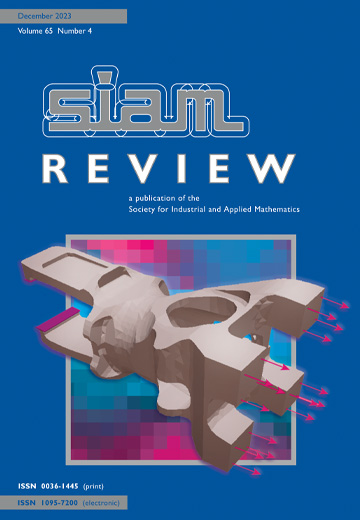Research Spotlights
IF 6.1
1区 数学
Q1 MATHEMATICS, APPLIED
引用次数: 0
Abstract
SIAM Review, Volume 65, Issue 4, Page 1029-1029, November 2023.This issue's two Research Spotlights highlight techniques for obtaining ever more realistic solutions to challenging systems of partial differential equations (PDEs). Although borne from different fields of applied mathematics, both papers aim to leverage prior information to improve the fidelity and practical solution of PDEs. How predictive is a model if it violates constraints known to be satisfied by the underlying physical phenomena or otherwise imposed by numerical stability requirements? Fundamentally, one desires to avoid nonlinear instabilities, nonphysical solutions, and numerical method divergence whenever these constraints are known a priori, but this pursuit is often easier said than done. In this issue's first Research Spotlight, “Geometric Quasilinearization Framework for Analysis and Design of Bound-Preserving Schemes,” authors Kailiang Wu and Chi-Wang Shu extend the range of systems of PDEs for which bound constraints can be imposed on solutions. For example, solutions of the special relativistic magnetohydrodynamic equations have fluid velocities upper bounded by the speed of light. Such constraint equations, and many others illustrated by the authors, are nonlinear and hence challenging to enforce. The authors lift such problems into a higher-dimensional space with the benefit of representing the original nonlinear constraints with higher-dimensional linear constraints based on the geometric properties of the underlying convex regions. The authors illuminate when such lifting results in an equivalent representation---a geometric quasilinearization (GQL)---and derive three techniques for constructing GQL-based bound-preserving methods in practice. The applicability of the resulting framework is based on the form of the nonlinear constraint, in this case based on convex feasible regions, but provides a potential path forward for satisfying even more general constraints. The second Research Spotlight addresses the estimation of unknown, spatially varying PDE system parameters from data. Of particular interest to authors David Aristoff and Wolfgang Bangerth are Bayesian formulations for such inverse problems since these formulations yield predictive distributions on the unknown parameters. Obtaining such a distribution can be highly beneficial for uncertainty quantification and other downstream uses, but Bayesian inversion quickly becomes computationally impractical as the dimension of the unknown parameters grows. More difficult still is validating the obtained distributions. In “A Benchmark for the Bayesian Inversion of Coefficients in Partial Differential Equations” the authors seek to advance the field and understanding of the state of the art through a comprehensive specification of a 64-dimensional benchmark problem. The authors provide a complete description of the underlying physical problem, data-generating process, likelihood, and prior, as well as open-source, multilanguage versions of the simple code to define the problem. The authors also provide the results of a comprehensive numerical examination of the problem, including 30 CPU-years worth of samples from the posterior distribution, and lower- and higher-dimensional extensions of the problem. The benchmark should be helpful for researchers wanting to test the efficacy of new algorithms and sampling approaches.
研究聚光灯
SIAM评论,第65卷,第4期,第1029-1029页,2023年11月。本期的两个研究热点强调了为具有挑战性的偏微分方程组(PDE)获得更现实的解决方案的技术。尽管来自应用数学的不同领域,但这两篇论文都旨在利用先验信息来提高偏微分方程的保真度和实用解。如果一个模型违反了已知的基本物理现象所满足的约束或数值稳定性要求所施加的约束,那么它的预测能力如何?从根本上说,只要这些约束是先验已知的,人们就希望避免非线性不稳定性、非物理解和数值方法的分歧,但这种追求往往说起来容易做起来难。在本期的第一个研究热点“保界方案分析与设计的几何拟线性化框架”中,作者吴开亮和舒志旺扩展了偏微分方程组的范围,对其解可以施加有界约束。例如,特殊相对论磁流体动力学方程的解的流体速度上限为光速。这种约束方程,以及作者所阐述的许多其他约束方程,都是非线性的,因此难以实施。作者将这些问题提升到更高维的空间中,其好处是基于底层凸区域的几何性质,用更高维线性约束来表示原始非线性约束。作者阐明了这种提升何时导致等价表示——几何拟线性化(GQL)——并推导了在实践中构造基于GQL的边界保持方法的三种技术。所得框架的适用性基于非线性约束的形式,在这种情况下基于凸可行域,但为满足更一般的约束提供了潜在的前进道路。第二个研究聚光灯解决了从数据中估计未知的、空间变化的PDE系统参数的问题。作者David Aristoff和Wolfgang Bangerth特别感兴趣的是这种反问题的贝叶斯公式,因为这些公式在未知参数上产生预测分布。获得这样的分布对于不确定性量化和其他下游用途可能非常有益,但随着未知参数的维数增长,贝叶斯反演在计算上很快变得不切实际。更困难的是验证所获得的分布。在“偏微分方程中系数的贝叶斯反演的基准”中,作者试图通过对64维基准问题的全面说明来推进该领域和对现有技术的理解。作者提供了对潜在物理问题、数据生成过程、可能性和先前的完整描述,以及定义问题的简单代码的开源多语言版本。作者还提供了对该问题的全面数值检验的结果,包括来自后验分布的30 CPU年的样本,以及该问题的低维和高维扩展。该基准应该有助于研究人员测试新算法和采样方法的有效性。
本文章由计算机程序翻译,如有差异,请以英文原文为准。
求助全文
约1分钟内获得全文
求助全文
来源期刊

SIAM Review
数学-应用数学
CiteScore
16.90
自引率
0.00%
发文量
50
期刊介绍:
Survey and Review feature papers that provide an integrative and current viewpoint on important topics in applied or computational mathematics and scientific computing. These papers aim to offer a comprehensive perspective on the subject matter.
Research Spotlights publish concise research papers in applied and computational mathematics that are of interest to a wide range of readers in SIAM Review. The papers in this section present innovative ideas that are clearly explained and motivated. They stand out from regular publications in specific SIAM journals due to their accessibility and potential for widespread and long-lasting influence.
 求助内容:
求助内容: 应助结果提醒方式:
应助结果提醒方式:


